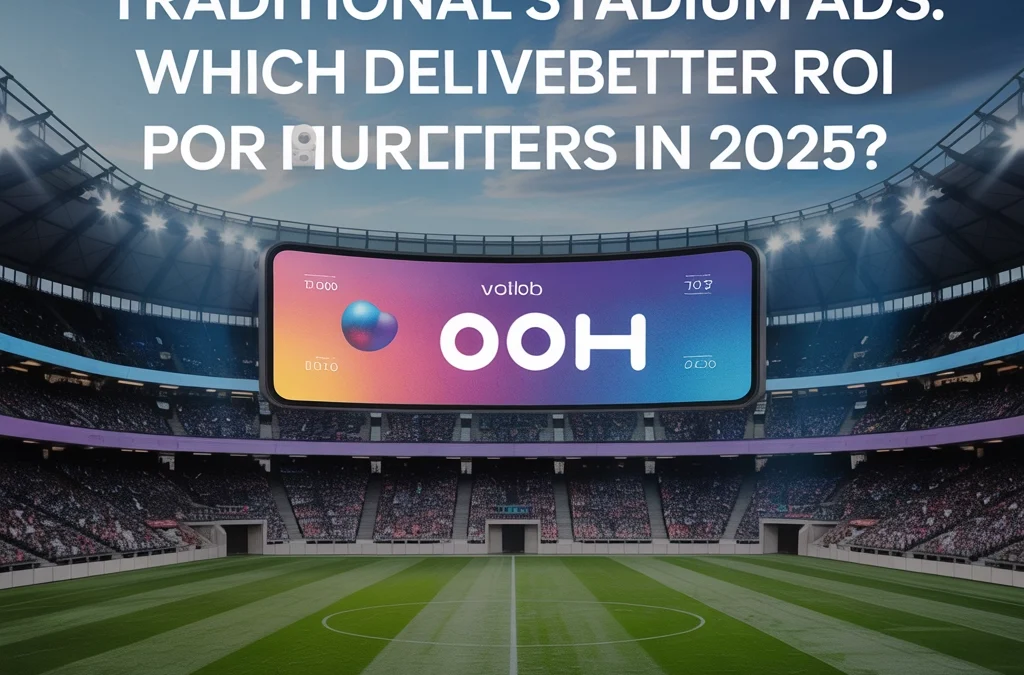Share this article: LinkedIn | Facebook | Instagram | X
AI-powered DOOH advertising delivers significantly better ROI for sports marketers in 2025 compared to traditional stadium ads. The combination of real-time data analytics, dynamic content capabilities, and precision targeting makes AI-driven digital displays 30-50% more effective in generating returns on investment. While traditional stadium advertising maintains value for broad brand awareness, the measurability and adaptability of AI-powered DOOH systems provide sports marketers with superior performance optimization and audience engagement.
The shift toward #Innovation in sports #Marketing reflects broader industry trends where data-driven #Strategy increasingly determines campaign success. Sports brands investing in AI-powered DOOH technology achieve measurable advantages in both engagement metrics and cost efficiency.
Understanding AI-Powered DOOH Technology
AI-powered DOOH systems leverage sophisticated machine learning algorithms and real-time data analytics to optimize campaign performance continuously. These platforms analyze consumer behavior patterns, demographic data, and contextual factors to ensure maximum ad relevance and impact.
Core Technical Capabilities
Programmatic advertising functionality enables automated ad space purchasing based on real-time data, eliminating manual placement inefficiencies. Dynamic content management systems allow instant creative updates across multiple display networks, ensuring contextual relevance during live sporting events.
Location-based targeting utilizes geofencing technology and mobile device data to reach consumers at optimal moments. Smart scheduling algorithms adjust ad frequency and timing based on foot traffic patterns, weather conditions, and event schedules.
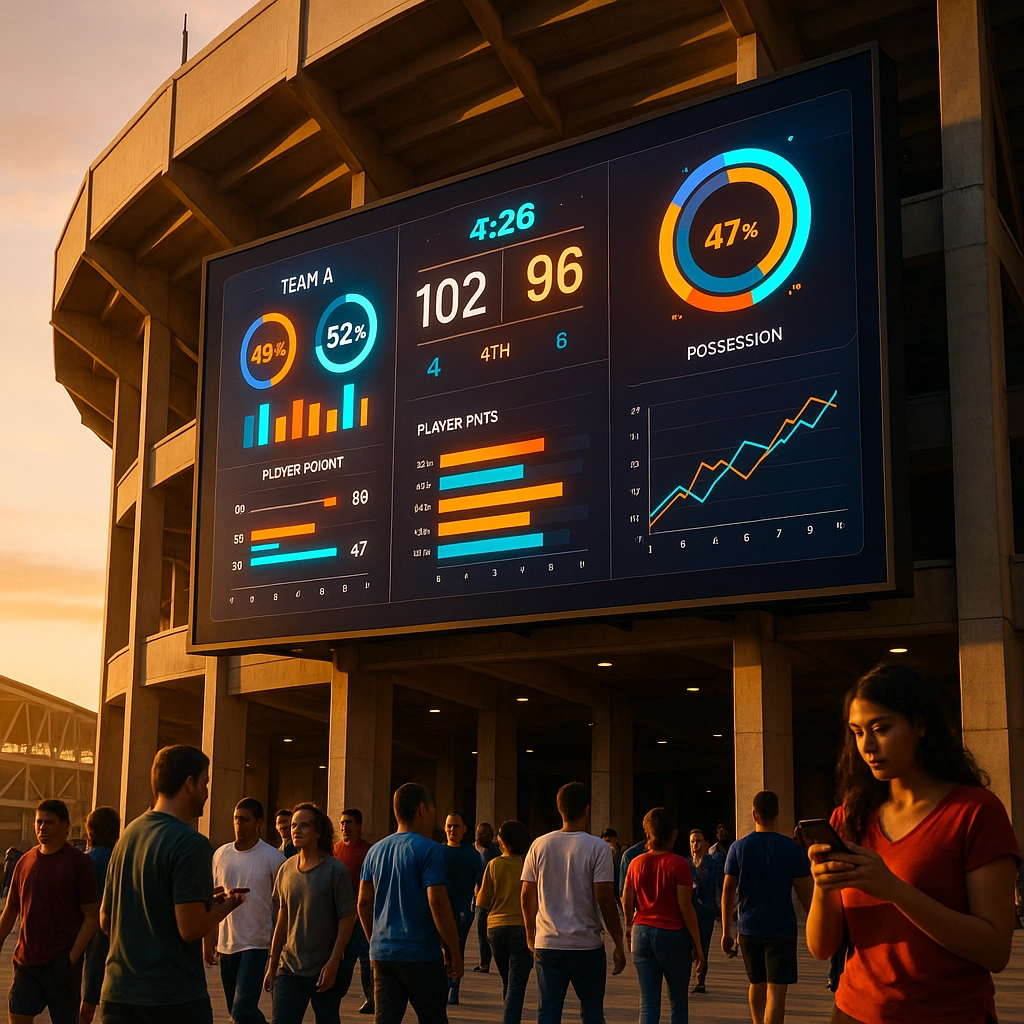
Performance Advantages
AI-enhanced displays demonstrate engagement rates 300% higher than traditional static displays. Augmented reality integration extends typical interaction durations to 75 seconds, compared to the 2-3 second viewing time associated with traditional billboard advertising.
Real-time optimization capabilities enable immediate campaign adjustments during live events. Sports brands can update promotions, display live scores, or modify messaging based on game developments, creating contextually relevant engagement opportunities.
The #digitalmarketing landscape increasingly favors these adaptive technologies, particularly in sports environments where emotional engagement peaks during critical game moments.
Traditional Stadium Advertising Framework
Traditional stadium advertising encompasses static billboards, field-level signage, sponsored sections, and physical displays within sports venues. These placements capitalize on captive audiences during sporting events, where viewers cannot skip or block advertising content.
Established Benefits
High-visibility placements during marquee sporting events create significant brand exposure opportunities. The physical presence and scale of traditional signage generate memorable brand impressions during emotionally charged sporting moments.
Association with popular teams and venues enhances brand credibility through environmental context. Premium placement locations, such as behind home plate or center court, command attention during television broadcasts and live attendance.
Operational Limitations
Static content limitations prevent real-time updates or contextual messaging adjustments. Traditional installations require significant lead times for creative development, approval processes, and physical installation procedures.
Measurement capabilities remain limited compared to digital alternatives. Performance tracking relies primarily on estimated viewership data rather than precise engagement metrics or behavioral attribution.
Cost structures favor long-term commitments with limited flexibility for budget reallocation or campaign optimization based on performance data.
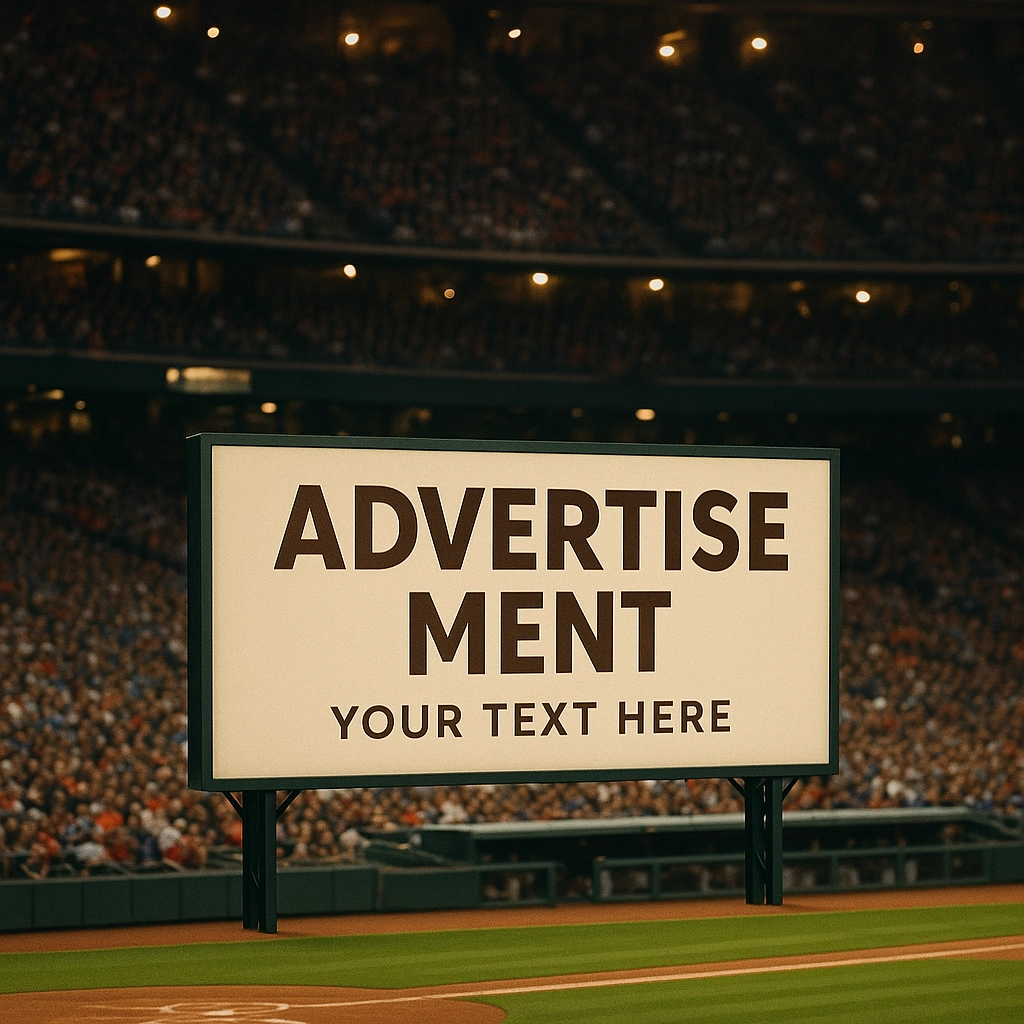
Comparative Performance Analysis
The performance differential between AI-powered DOOH and traditional stadium advertising becomes evident across multiple measurement dimensions.
Engagement Metrics
AI-powered systems generate substantially higher engagement rates through dynamic content and interactive capabilities. Traditional stadium ads achieve passive brand exposure but lack mechanisms for measuring or optimizing viewer interaction.
Data from recent campaigns demonstrates that AI-enhanced displays maintain viewer attention for extended periods, particularly when incorporating augmented reality elements or real-time content updates.
Targeting Precision
AI-powered DOOH platforms utilize demographic data, behavioral patterns, and contextual factors to deliver personalized messaging. Traditional stadium advertising relies solely on venue-based targeting without audience segmentation capabilities.
Programmatic buying enables AI systems to optimize ad placement timing and frequency based on audience composition and engagement probability. Traditional placements operate on fixed schedules regardless of audience dynamics.
Cost Efficiency
Programmatic buying mechanisms reduce media costs through automated optimization and real-time bidding. Traditional stadium advertising involves fixed pricing structures with limited negotiation flexibility.
AI systems enable budget allocation optimization across multiple placements and time periods. Traditional campaigns require upfront commitments without performance-based adjustment capabilities.
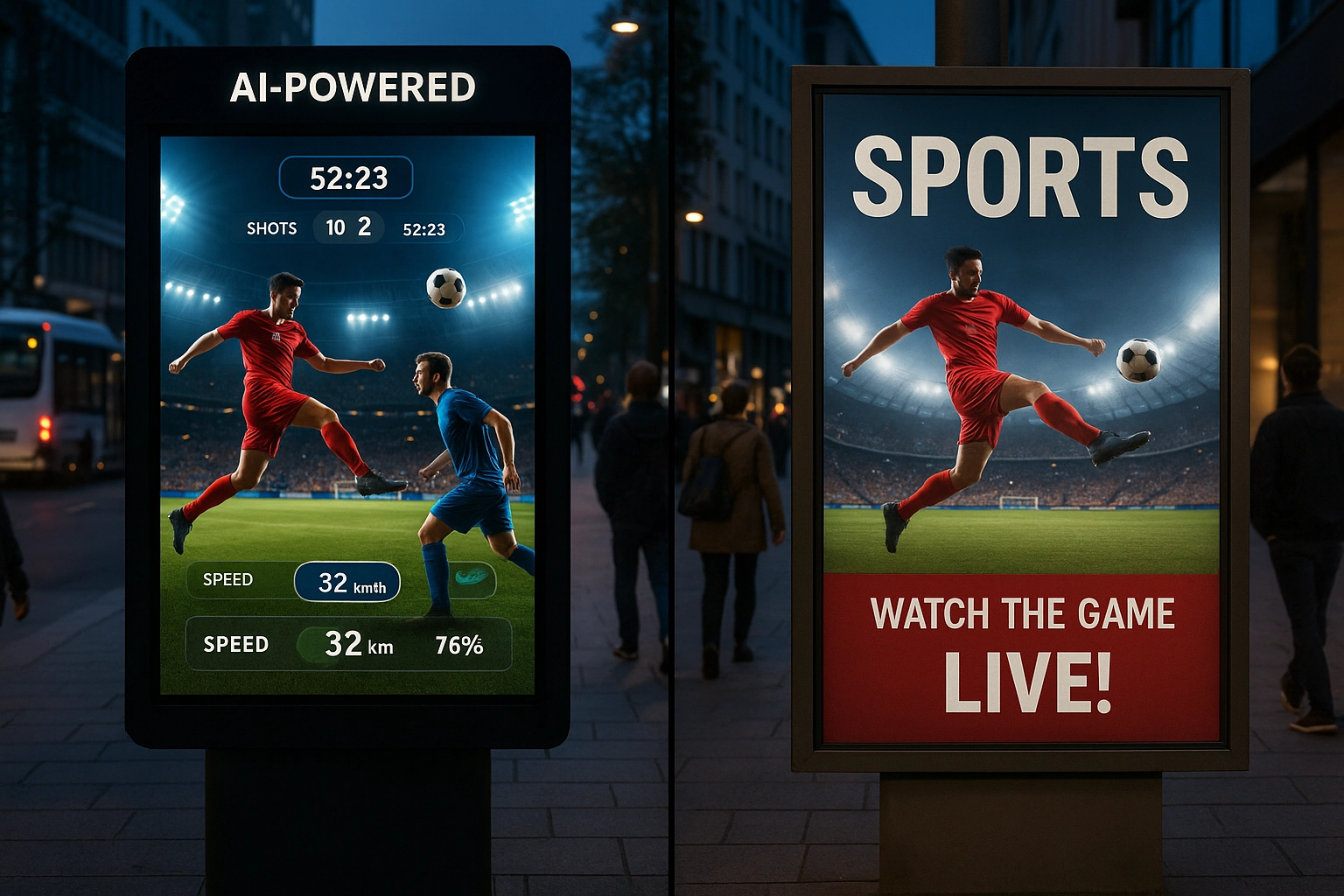
| Performance Factor | AI-Powered DOOH | Traditional Stadium Ads |
|---|---|---|
| ROI Improvement | 30-50% higher returns | Baseline performance |
| Engagement Rate | 300% above static displays | 2-3 second viewing time |
| Content Flexibility | Real-time updates, animations | Static throughout campaign |
| Targeting Capability | Demographic and behavioral data | Location-based only |
| Measurement Depth | Comprehensive analytics | Limited viewership estimates |
| Budget Optimization | Programmatic, real-time adjustments | Fixed commitments |
| Setup Timeline | Immediate deployment possible | Weeks to months |
Strategic Implementation Recommendations
Sports marketers should evaluate AI-powered DOOH investment based on specific campaign objectives and measurement priorities.
Maximum ROI Strategy
Organizations prioritizing measurable returns should allocate primary budget toward AI-powered DOOH systems. The speed, precision, and data-driven optimization capabilities enable continuous performance improvement throughout campaign duration.
Integration with social media advertising, mobile campaigns, and geofencing strategies creates unified #AdvertisingAndMarketing ecosystems that traditional stadium ads cannot support. This omnichannel approach amplifies message reach while maintaining cost efficiency.
Brand Prestige Approach
Premium sports brands seeking both performance metrics and brand association benefits should implement hybrid strategies combining AI-powered DOOH for targeted campaigns with selective traditional stadium placements for marquee events.
This balanced approach leverages the measurability and efficiency of digital systems while maintaining high-visibility brand presence during significant sporting moments. The #Branding impact of premium stadium placements complements the performance optimization of AI-driven systems.
Budget-Conscious Implementation
Smaller sports organizations achieve superior value through AI-powered DOOH, which eliminates high installation costs and lengthy commitment periods associated with traditional stadium advertising.
Programmatic buying capabilities ensure efficient budget allocation and immediate campaign adjustments based on performance data. This flexibility enables rapid strategy pivots without financial penalties.
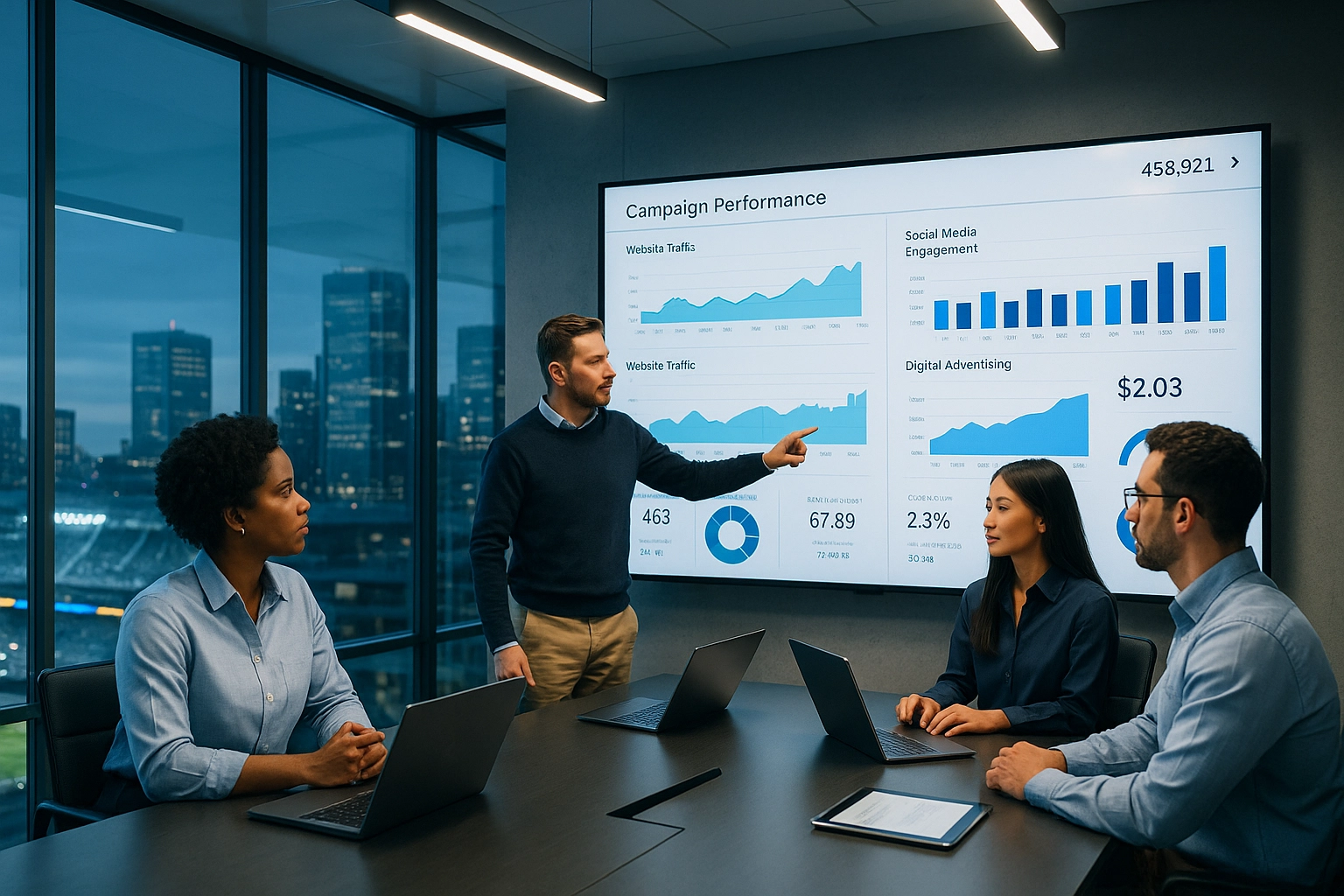
The #Sports marketing landscape increasingly rewards organizations that embrace technological innovation while maintaining strategic focus on measurable outcomes. Companies like Nike have demonstrated how strategic DOOH implementation can create significant brand impact without traditional sponsorship investments.
Future Market Projections
The AI-powered DOOH market continues expanding as sports organizations recognize the measurable advantages of data-driven advertising systems. Industry projections indicate that DOOH sports advertising will reach $50 billion by 2030, with AI-enhanced platforms capturing the majority of growth.
Traditional stadium advertising will maintain market presence for specific use cases, particularly brand prestige campaigns and long-term partnership visibility. However, the performance gap between AI-powered systems and traditional placements will continue widening as technology capabilities advance.
Sports marketers investing in AI-powered DOOH technology position their organizations for sustained competitive advantage in an increasingly data-driven marketplace. The combination of superior ROI, enhanced targeting precision, and comprehensive measurement capabilities makes AI-enhanced systems the optimal choice for performance-focused campaigns.
Take Action on Your Sports Marketing Strategy
Sports marketers ready to optimize their advertising ROI should evaluate AI-powered DOOH implementation as a strategic priority. The performance advantages, cost efficiency, and measurement capabilities provide clear competitive benefits in today’s data-driven marketing environment.
For expert guidance on implementing AI-powered DOOH strategies tailored to sports marketing objectives, contact OOH Sports at +1 (970) 703-0102. Dan Kost, CEO, and the OOH Sports team specialize in developing comprehensive DOOH campaigns that maximize ROI while building lasting brand engagement.
Visit oohsports.com to explore case studies, strategic frameworks, and implementation resources designed specifically for sports marketing professionals seeking measurable advertising success.
Keywords: #Motivation #Branding #Strategy #Marketing #AdvertisingAndMarketing #digitalmarketing #Innovation #Sports

